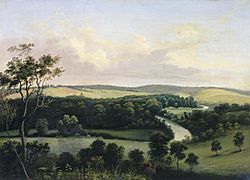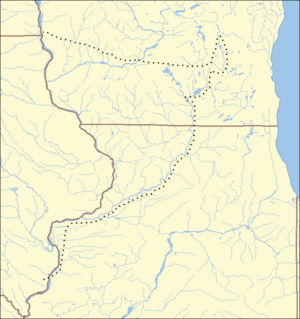Battle of Horseshoe Bend (1832) facts for kids
Quick facts for kids Battle of Horseshoe Bend |
|||||||
|---|---|---|---|---|---|---|---|
| Part of the Black Hawk War | |||||||
 An 1857 painting of the battlefield at Horseshoe Bend. |
|||||||
|
|||||||
| Belligerents | |||||||
| Kickapoo; loosely affiliated with Black Hawk's British Band | |||||||
| Commanders and leaders | |||||||
| Henry Dodge | |||||||
| Strength | |||||||
| 30 | 11 | ||||||
| Casualties and losses | |||||||
| 3 KIA 1 WIA |
11 KIA | ||||||
|
Pecatonica Battlefield
|
|
| Location | 2995 County Road Y |
|---|---|
| Nearest city | Woodford, Wisconsin |
| NRHP reference No. | 11000488 |
| Added to NRHP | July 28, 2011 |
The Battle of Horseshoe Bend, also called the Battle of Pecatonica, happened on June 16, 1832. It took place in what is now Wisconsin. The battle was fought near an oxbow lake on the Pecatonica River. This small victory was a big turning point in the Black Hawk War.
It helped people trust the American volunteer soldiers again. This was important after a tough loss at Stillman's Run. At Horseshoe Bend, three American soldiers died. All eleven Kickapoo warriors involved were killed. This battle showed the bravery and discipline of the American militia.
Contents
Why the Battle Happened
The Black Hawk War started because of a land dispute. In 1804, a treaty was made about Sauk and Fox lands in Illinois. Many Sauk and Fox leaders said the treaty was not fair. They claimed their full tribal councils were not asked. They also said the people who signed it did not have permission.
Sauk Chief Black Hawk was upset about losing his homeland. From 1830 to 1831, he led his people back into Illinois several times. Each time, he was convinced to return west without fighting. In April 1832, Black Hawk returned with his "British Band." This group included about 1000 warriors and their families. He hoped other tribes and the British would join him.
However, Black Hawk found no allies. He tried to go back to Iowa. But the Illinois Militia attacked his group. This led to the Battle of Stillman's Run. After this, more small fights and attacks happened. The militias from Michigan Territory and Illinois began hunting Black Hawk's Band. This conflict became known as the Black Hawk War.
Events Before the Battle
Many things happened between Stillman's Run and Horseshoe Bend. There were attacks at Buffalo Grove and the Plum River settlement. There were also attacks at Fort Blue Mounds. The sad Indian Creek massacre also happened during this time.
Colonel Henry Dodge was a leader of the Michigan Territory militia. He was very busy responding to these events. On June 8, 1832, Dodge and his men buried victims of the St. Vrain massacre. Dodge then moved to Hickory Point for the night. The next morning, he went to Dixon's Ferry. There he camped with General Hugh Brady.
Getting Ready for Battle
On June 11, Colonel Dodge met with General Henry Atkinson. Atkinson was the main commander. Dodge was given clear power to handle the violence in the mining area. He went back to his home fort at Gratiot's Grove. He arrived there on June 13.
The Spafford Farm massacre happened the next day. Dodge immediately went to Fort Hamilton. He stopped at Fort Blue Mounds for supplies. On his way, he passed a German immigrant named Henry Apple. They greeted each other and Dodge continued.
Soon after, Dodge's soldiers heard gunshots. Apple had been attacked by Kickapoo warriors. This attack was likely meant for Dodge himself. Dodge was probably saved because he took a different route. Later, Apple's wounded horse galloped back past the soldiers. The horse then ran all the way to Fort Hamilton. This caused a lot of alarm there.
The Kickapoo group that attacked Apple had eleven warriors. This same group had killed five men at Spafford Farm. This Kickapoo band was only loosely connected to Black Hawk's main group.
When Dodge heard the gunshots, he rushed to Fort Hamilton. This fort is near present-day Wiota, Wisconsin. There, he gathered 29 volunteer soldiers on horseback. They quickly rode off to stop the attackers. Dodge led the chase through thick bushes. When they reached a prairie, they saw the Kickapoo group.
The Kickapoo crossed the Pecatonica River. They then went into a thick swamp. Dodge's militia followed them across the river. They got off their horses when they reached the swamp.
The Battle Begins
Dodge's men dismounted their horses. Dodge then gave his men a chance to leave if they wanted. No one left. Twenty-one men went forward with Dodge. They formed a long line, not knowing where the enemy was. The other eight soldiers stayed behind. They guarded the high ground and the horses.
Unlike the confused soldiers at Stillman's Run, these volunteers were disciplined. They waited for Dodge's orders. They did not enter the swamp until he told them to. Once inside, they waited for his command to attack.
The militia moved about 200 yards (200 m) into the swamp. Suddenly, the Kickapoo warriors yelled loudly. They were hidden on the bank of an oxbow lake. The warriors fired their weapons at the militia. Three American soldiers were hit: Samuel Black, Samuel Wells, and Montaville Morris. They all fell.
Dodge did not hesitate. He ordered his men to charge. They obeyed. They waited until they were very close, about six feet away, before firing their weapons. After the first charge and shots, the fight became hand-to-hand. Soldiers used tomahawks, bayonets, muskets, and spears.
The fighting lasted only a few minutes. Nine Kickapoo warriors were killed right there. The other two were killed while trying to escape across the lake. During the hand-to-hand fight, a fourth militia member, Thomas Jenkins, was wounded. Even though it was short, the Battle of Horseshoe Bend had a big impact on the rest of the war.
After the Battle

The Battle of Horseshoe Bend was not a huge military event. But it was a major turning point for the volunteer soldiers. It also changed how white settlers viewed the militia. This small victory helped the militia feel confident again. It also improved their reputation on the frontier.
Some people said the battle "turned the tide of the war." It was also notable for how many people died compared to how many fought. All eleven Kickapoo warriors were killed. The militia had three soldiers killed and one wounded.
Thomas Jenkins, the wounded militia man, was only slightly hurt. However, the three soldiers who were shot earlier all died later. Samuel Wells, Montaville Morris, and Samuel Black were taken to Fort Hamilton. Morris died at the fort. Wells also died there, with his head in a friend's lap. Before he died, Wells asked Dodge if he had "behaved like a soldier." Dodge replied, "Yes, Wells, like a brave one." Wells then asked Dodge to "Send that word to my old father." He died soon after. Samuel Black was moved to Fort Defiance. He lived for nine more days before he died.
This was the first time a volunteer force defeated Native Americans in this war. Dodge was the first militia leader to prove he could stand up to the enemy. He quickly became a "rising star" in the conflict. He had helped free the Hall sisters after the Indian Creek massacre. Now he proved himself at Horseshoe Bend.
Today, the battlefield at Horseshoe Bend is a campground. It is part of a county park in Lafayette County, Wisconsin. The Black Hawk Memorial Park is cared for by several groups. These include the Lafayette County Sportsmen Alliance and the Friends of Woodford Park. In 1922, a marker was put up to remember the battle. It was placed by the Shullsburg chapter of the Daughters of the American Revolution and people from Wiota. You can still see it today. The battlefield was added to the National Register of Historic Places on July 28, 2011.
Images for kids





